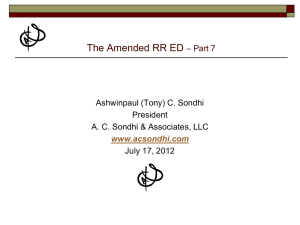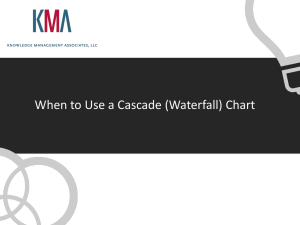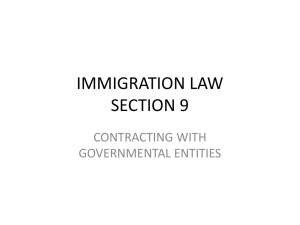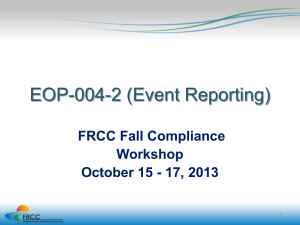REVENUE RECOGNITION
advertisement
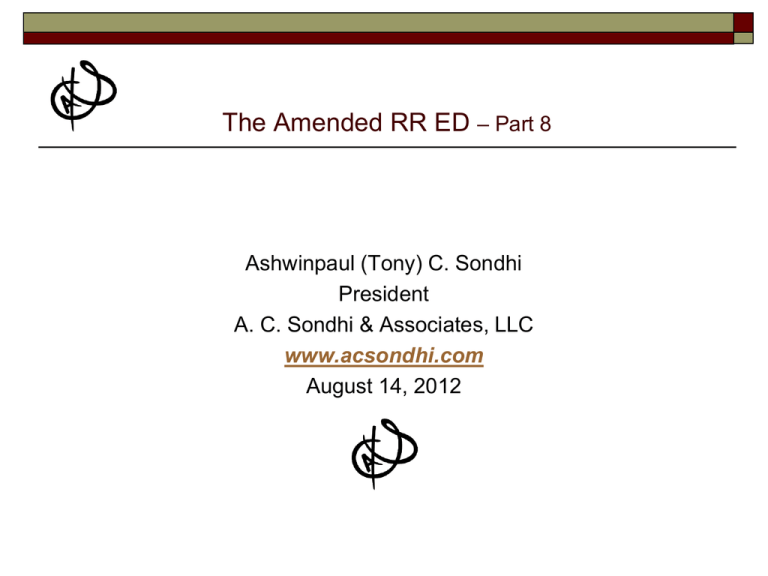
The Amended RR ED – Part 8 Ashwinpaul (Tony) C. Sondhi President A. C. Sondhi & Associates, LLC www.acsondhi.com August 14, 2012 The Amended RR ED: Part 8 My objective in this webcast series is to discuss specific financial reporting risks to clarify industry specific issues relevant to financial statement preparers, auditors, and investors as the FASB and the IASB work to complete. The Comment period for the Amended RR ED ended March 13, 2012. I strongly encourage everyone to review the comment letters the Boards have received to date. See www.FASB.org and www.IASB.org for more information on and staff summaries of comment letters. 4/9/2015 Copyright 2012 A. C. Sondhi & Associates, LLC 2 Proposed Revenue ASU Revenue Recognition Road Map Principles: Step 1: Identify the contract(s) with the customer. Step 2: Identify the separate performance obligations in the contract. Step 3: Determine the Transaction Price. Step 4: Allocate the Transaction Price. Step 5: Recognize revenue when a performance obligation is satisfied. 4/9/2015 Copyright 2012 A. C. Sondhi & Associates, LLC 3 Proposed Revenue ASU Allocation of the Transaction Price Principle: For a contract that has more than one separate performance obligation, an entity shall allocate the transaction price to each separate performance obligation in an amount that depicts the amount of consideration to which the entity expects to be entitled in exchange for satisfying each performance obligation. 4/9/2015 Copyright 2012 A. C. Sondhi & Associates, LLC 4 Standalone Selling Price: Proposed Revenue ASU Revised November, 2011 Basic Principle – Paragraph 71: To allocate an appropriate amount of consideration to each separate performance obligation, at contract inception, an entity shall determine the standalone selling price of the good or service underlying each separate performance obligation and allocate the transaction price on a relative standalone selling price basis. Definition of standalone selling price: The price at which an entity would sell a promised good or service separately to a customer. 4/9/2015 Copyright 2012 A. C. Sondhi & Associates, LLC 5 Standalone Selling Price: Proposed Revenue ASU Revised November, 2011 Paragraph 72: The best evidence of a standalone selling price is the observable price of a good or service when the entity sells that good or service Separately, in similar circumstances, and to similar customers. A contractually stated price or a list price for a good or service may be (but shall not be presumed to be) the standalone selling price of that good or service. 4/9/2015 Copyright 2012 A. C. Sondhi & Associates, LLC 6 Estimation of a Standalone Selling Price: Proposed Revenue ASU Revised November, 2011 Paragraph 73 – If a standalone selling price is not directly observable, an entity shall estimate it. Estimation of a standalone selling price should consider all of the following information when it is reasonably available to the entity: Market conditions, Entity-specific factors, and Information about the customer or class of customers. An entity shall: Maximize the use of observable inputs, and Apply estimation methods consistently in similar circumstances. 4/9/2015 Copyright 2012 A. C. Sondhi & Associates, LLC 7 Examples of Suitable Estimation Methods: Paragraph 73 (a) Adjusted market assessment approach: Estimate the price that customers would be willing to pay goods or services in the market in which it sells those goods or services. The entity may also consider prices charged by its competitors for similar goods or services adjusting those prices as necessary to reflect its own costs and margins. 4/9/2015 Copyright 2012 A. C. Sondhi & Associates, LLC 8 Examples of Suitable Estimation Methods: Paragraph 73 (b) Expected costs plus a margin approach: An entity would begin with a forecast of the expected costs of satisfying a performance obligation and add an appropriate margin for that good or service. 4/9/2015 Copyright 2012 A. C. Sondhi & Associates, LLC 9 Examples of Suitable Estimation Methods: Paragraph 73 (c) Residual approach: If the standalone selling price of a good or service is highly variable or uncertain, the standalone selling price may be estimated using the residual approach. Residual approach: Total transaction price less the sum of the observable standalone selling prices of other goods or services promised in the contract. 4/9/2015 Copyright 2012 A. C. Sondhi & Associates, LLC 10 Residual Approach: Paragraph 73 (c) Highly variable: At or near the same time, the same good or service is sold to different customers for a broad range of amounts. Uncertain: The entity has (1) not yet established a price for the good or service, and (2) the good or service has not previously been sold. 4/9/2015 Copyright 2012 A. C. Sondhi & Associates, LLC 11 Discounts: Proposed Revenue ASU Revised November, 2011 Basic Principle - Paragraph 74: Discounts shall be allocated to all separate performance obligations on the basis of the relative standalone selling prices. See Exceptions in Paragraphs 75 and 76. 4/9/2015 Copyright 2012 A. C. Sondhi & Associates, LLC 12 Discounts: Proposed Revenue ASU Revised November, 2011 Paragraph 75: A discount shall be allocated entirely to one (or some) separate performance obligation(s) if both of the following criteria are met: a) The entity regularly sells each good or service (or each bundle of goods or services) in the contract on a standalone basis, and b) The observable selling price from those standalone sales provide evidence of the performance obligation(s) to which the entire discount in the contract belongs. Question: Can a discount be allocated entirely to one (or some) separate performance obligation(s) if the residual approach was used to establish the selling price of one or more goods or services in the contract? 4/9/2015 Copyright 2012 A. C. Sondhi & Associates, LLC 13 Discounts: Proposed Revenue ASU Revised November, 2011 Paragraph 76: If the transaction price includes an amount of consideration that is contingent on a future event or circumstance (for example, an entity’s performance or a specific outcome of the entity’s performance), the entity shall allocate that contingent amount (and subsequent changes to the amount) entirely to a distinct good or service if both of the following criteria are met: a) The contingent payment terms for the distinct good or service relate specifically to the entity’s efforts to transfer that good or service (or to a specific outcome from transferring that good or service). b) Allocating the contingent amount of consideration entirely to the distinct good or service is consistent with the allocation principle in Paragraph 70 when considering all of the performance obligations and payment terms in the contract. 4/9/2015 Copyright 2012 A. C. Sondhi & Associates, LLC 14 Tony Sondhi’s Summer and Fall 2012 Seminar Schedule Topic Dates Location Advanced Topics in Software Revenue Recognition August 20 & 21 Boston, MA Contracts September 14 October 8 November 19 Raleigh, NC San Jose, CA San Diego, CA Software Revenue Recognition September 17 & 18 September 24 & 25 San Jose, CA Boston, MA Revenue Recognition August 23 & 24 October 1 & 2 Boston, MA Boston, MA Cloud Computing (SaaS) Advanced Topics in Cloud Computing October 15 October 16 San Jose, CA San Jose, CA Please visit www.acsondhi.com or call 727-797-1515 for agenda and registration information. 4/9/2015 Copyright 2012 A. C. Sondhi & Associates, LLC 15 Tony Sondhi’s Summer and Fall 2012 Seminar Schedule Topic Dates Location NEW! Statement of Cash Flows October 22 October 29 San Jose, CA Boston, MA NEW! Financial Reporting & Risks in Gaming and Social Software November 9 November 16 San Jose, CA Boston, MA Advanced Topics in Software Revenue Recognition December 10 & 11 December 17 & 18 Boston, MA San Jose, CA Advanced Topics in Revenue Recognition December 13 & 14 San Jose, CA Please visit www.acsondhi.com or call 727-797-1515 for agenda and registration information. 4/9/2015 Copyright 2012 A. C. Sondhi & Associates, LLC 16
